Pragmatic Failure in the Cross-Cultural Communication 跨文化交际中的语用失误
- 格式:doc
- 大小:114.00 KB
- 文档页数:28
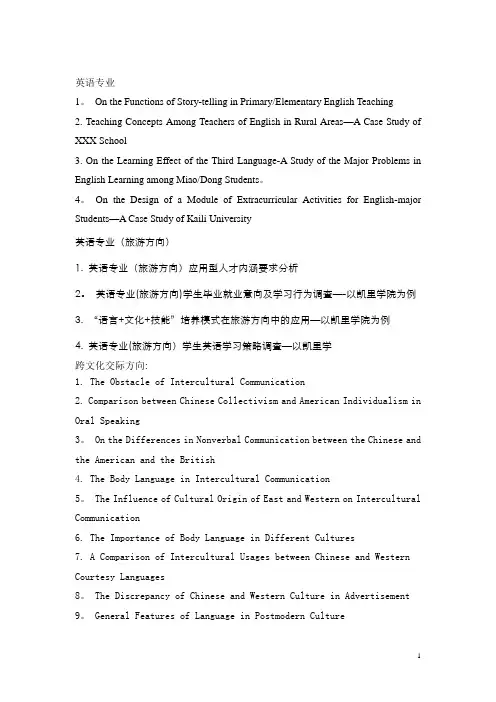
英语专业1。
On the Functions of Story-telling in Primary/Elementary English Teaching2. Teaching Concepts Among Teachers of English in Rural Areas—A Case Study of XXX School3. On the Learning Effect of the Third Language-A Study of the Major Problems in English Learning among Miao/Dong Students。
4。
On the Design of a Module of Extracurricular Activities for English-major Students—A Case Study of Kaili University英语专业(旅游方向)1. 英语专业(旅游方向)应用型人才内涵要求分析2。
英语专业(旅游方向)学生毕业就业意向及学习行为调查—-以凯里学院为例3. “语言+文化+技能”培养模式在旅游方向中的应用—以凯里学院为例4. 英语专业(旅游方向)学生英语学习策略调查—以凯里学跨文化交际方向:1. The Obstacle of Intercultural Communication2. Comparison between Chinese Collectivism and American Individualism in Oral Speaking3。
On the Differences in Nonverbal Communication between the Chinese and the American and the British4. The Body Language in Intercultural Communication5。
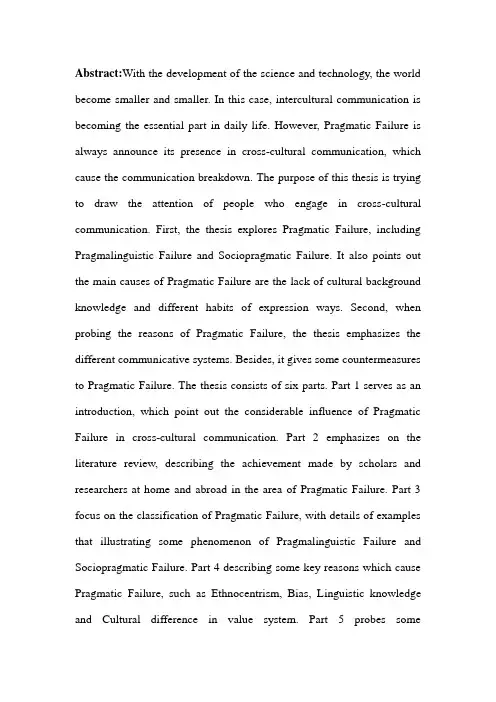
Abstract:With the development of the science and technology, the world become smaller and smaller. In this case, intercultural communication is becoming the essential part in daily life. However, Pragmatic Failure is always announce its presence in cross-cultural communication, which cause the communication breakdown. The purpose of this thesis is trying to draw the attention of people who engage in cross-cultural communication. First, the thesis explores Pragmatic Failure, including Pragmalinguistic Failure and Sociopragmatic Failure. It also points out the main causes of Pragmatic Failure are the lack of cultural background knowledge and different habits of expression ways. Second, when probing the reasons of Pragmatic Failure, the thesis emphasizes the different communicative systems. Besides, it gives some countermeasures to Pragmatic Failure. The thesis consists of six parts. Part 1 serves as an introduction, which point out the considerable influence of Pragmatic Failure in cross-cultural communication. Part 2 emphasizes on the literature review, describing the achievement made by scholars and researchers at home and abroad in the area of Pragmatic Failure. Part 3 focus on the classification of Pragmatic Failure, with details of examples that illustrating some phenomenon of Pragmalinguistic Failure and Sociopragmatic Failure. Part 4 describing some key reasons which cause Pragmatic Failure, such as Ethnocentrism, Bias, Linguistic knowledge and Cultural difference in value system. Part 5 probes somecountermeasures to Pragmatic Failure. Part6 “Conclusion”sums up the main findings of this paper.KEY WORDS: Pragmatic Failure; cross-cultural communication; Pragmalinguistic Failure; Sociopragmatic Failure; countermeasures摘要:随着科技的发展,世界变得越来越小。
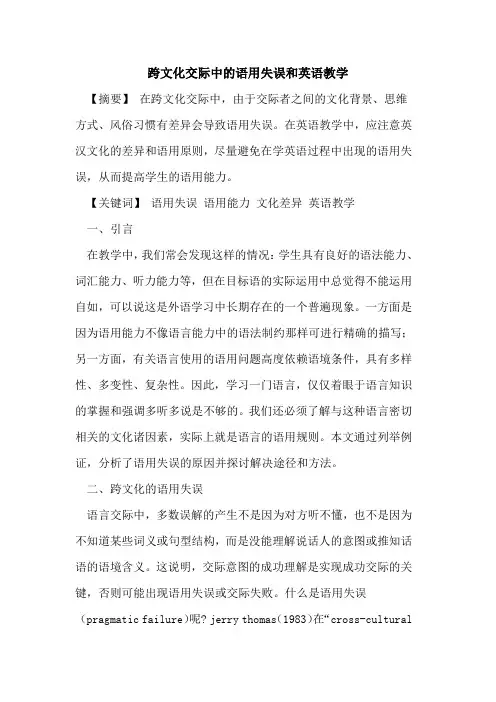
跨文化交际中的语用失误和英语教学【摘要】在跨文化交际中,由于交际者之间的文化背景、思维方式、风俗习惯有差异会导致语用失误。
在英语教学中,应注意英汉文化的差异和语用原则,尽量避免在学英语过程中出现的语用失误,从而提高学生的语用能力。
【关键词】语用失误语用能力文化差异英语教学一、引言在教学中,我们常会发现这样的情况:学生具有良好的语法能力、词汇能力、听力能力等,但在目标语的实际运用中总觉得不能运用自如,可以说这是外语学习中长期存在的一个普遍现象。
一方面是因为语用能力不像语言能力中的语法制约那样可进行精确的描写;另一方面,有关语言使用的语用问题高度依赖语境条件,具有多样性、多变性、复杂性。
因此,学习一门语言,仅仅着眼于语言知识的掌握和强调多听多说是不够的。
我们还必须了解与这种语言密切相关的文化诸因素,实际上就是语言的语用规则。
本文通过列举例证,分析了语用失误的原因并探讨解决途径和方法。
二、跨文化的语用失误语言交际中,多数误解的产生不是因为对方听不懂,也不是因为不知道某些词义或句型结构,而是没能理解说话人的意图或推知话语的语境含义。
这说明,交际意图的成功理解是实现成功交际的关键,否则可能出现语用失误或交际失败。
什么是语用失误(pragmatic failure)呢? jerry thomas(1983)在“cross-culturalpragmatic failure”一文中给语用失误下的定义是“the inability to understand what is meant by what is said”(不能通过听到的话语来理解其含义)。
即在任何情况下,只要听话人推知的结果不是说话人所期待的用意或希望传递的交际信息,便可能导致语用失误(thomas,1983)。
语用失误不同于语法错误。
语法错误从语言表层结构就可以看出,受话者很容易发现,常常把这种错误归咎于说话者语言知识的缺乏,因此可以谅解。
语用失误则不然,如果一个能说一口流利外语的人出现语用失误,人们不会把他的失误归咎于其语言能力,而很可能认为他不友好或缺乏教养(thomas,1983:96-97)。
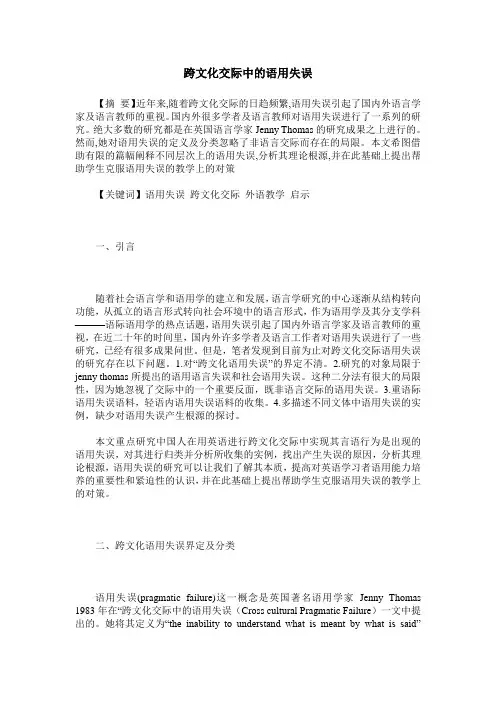
跨文化交际中的语用失误【摘要】近年来,随着跨文化交际的日趋频繁,语用失误引起了国内外语言学家及语言教师的重视。
国内外很多学者及语言教师对语用失误进行了一系列的研究。
绝大多数的研究都是在英国语言学家Jenny Thomas的研究成果之上进行的。
然而,她对语用失误的定义及分类忽略了非语言交际而存在的局限。
本文希图借助有限的篇幅阐释不同层次上的语用失误,分析其理论根源,并在此基础上提出帮助学生克服语用失误的教学上的对策【关键词】语用失误跨文化交际外语教学启示一、引言随着社会语言学和语用学的建立和发展,语言学研究的中心逐渐从结构转向功能,从孤立的语言形式转向社会环境中的语言形式,作为语用学及其分支学科———语际语用学的热点话题,语用失误引起了国内外语言学家及语言教师的重视,在近二十年的时间里,国内外许多学者及语言工作者对语用失误进行了一些研究,已经有很多成果问世。
但是,笔者发现到目前为止对跨文化交际语用失误的研究存在以下问题。
1.对“跨文化语用失误”的界定不清。
2.研究的对象局限于jenny thomas所提出的语用语言失误和社会语用失误。
这种二分法有很大的局限性,因为她忽视了交际中的一个重要反面,既非语言交际的语用失误。
3.重语际语用失误语料,轻语内语用失误语料的收集。
4.多描述不同文体中语用失误的实例,缺少对语用失误产生根源的探讨。
本文重点研究中国人在用英语进行跨文化交际中实现其言语行为是出现的语用失误,对其进行归类并分析所收集的实例,找出产生失误的原因,分析其理论根源,语用失误的研究可以让我们了解其本质,提高对英语学习者语用能力培养的重要性和紧迫性的认识,并在此基础上提出帮助学生克服语用失误的教学上的对策。
二、跨文化语用失误界定及分类语用失误(pragmatic failure)这一概念是英国著名语用学家Jenny Thomas 1983年在“跨文化交际中的语用失误(Cross cultural Pragmatic Failure)一文中提出的。
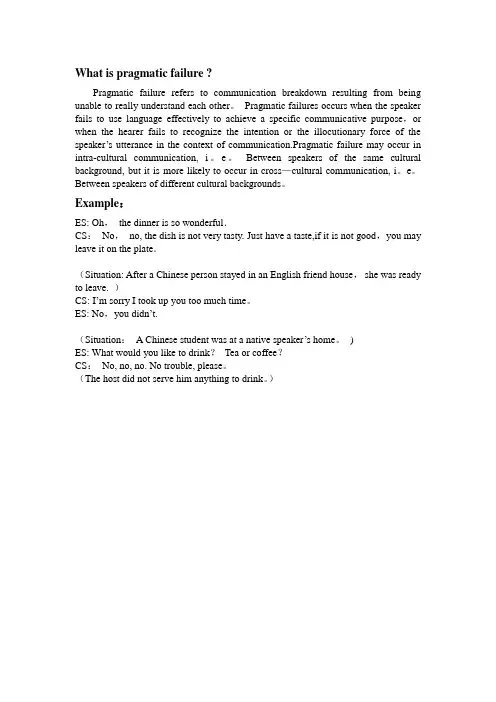
What is pragmatic failure ?Pragmatic failure refers to communication breakdown resulting from being unable to really understand each other。
Pragmatic failures occurs when the speaker fails to use language effectively to achieve a specific communicative purpose,or when the hearer fails to recognize the intention or the illocutionary force of the speaker’s utterance in the context of communication.Pragmatic failure may occur in intra-cultural communication, i。
e。
Between speakers of the same cultural background, but it is more likely to occur in cross—cultural communication, i。
e。
Between speakers of different cultural backgrounds。
Example:ES: Oh,the dinner is so wonderful.CS:No,no, the dish is not very tasty. Just have a taste,if it is not good,you may leave it on the plate.(Situation: After a Chinese person stayed in an English friend house,she was ready to leave. )CS: I’m sorry I took up you too much time。
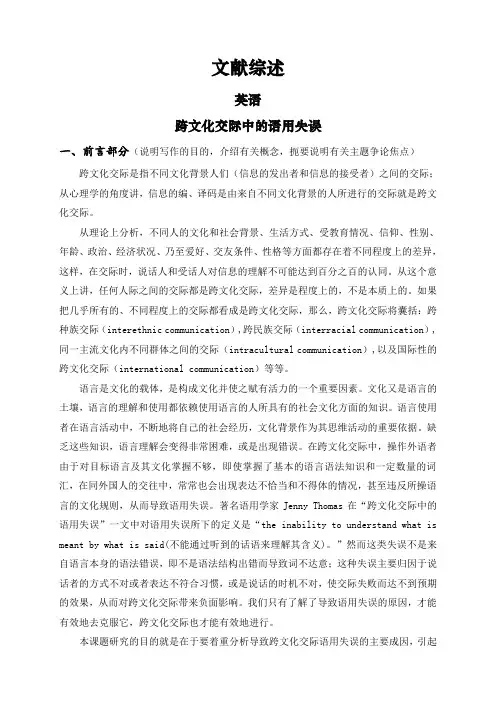
文献综述英语跨文化交际中的语用失误一、前言部分(说明写作的目的,介绍有关概念,扼要说明有关主题争论焦点)跨文化交际是指不同文化背景人们(信息的发出者和信息的接受者)之间的交际;从心理学的角度讲,信息的编、译码是由来自不同文化背景的人所进行的交际就是跨文化交际。
从理论上分析,不同人的文化和社会背景、生活方式、受教育情况、信仰、性别、年龄、政治、经济状况、乃至爱好、交友条件、性格等方面都存在着不同程度上的差异,这样,在交际时,说话人和受话人对信息的理解不可能达到百分之百的认同。
从这个意义上讲,任何人际之间的交际都是跨文化交际,差异是程度上的,不是本质上的。
如果把几乎所有的、不同程度上的交际都看成是跨文化交际,那么,跨文化交际将囊括:跨种族交际(interethnic communication),跨民族交际(interracial communication),同一主流文化内不同群体之间的交际(intracultural communication),以及国际性的跨文化交际(international communication)等等。
语言是文化的载体,是构成文化并使之赋有活力的一个重要因素。
文化又是语言的土壤,语言的理解和使用都依赖使用语言的人所具有的社会文化方面的知识。
语言使用者在语言活动中,不断地将自己的社会经历,文化背景作为其思维活动的重要依据。
缺乏这些知识,语言理解会变得非常困难,或是出现错误。
在跨文化交际中,操作外语者由于对目标语言及其文化掌握不够,即使掌握了基本的语言语法知识和一定数量的词汇,在同外国人的交往中,常常也会出现表达不恰当和不得体的情况,甚至违反所操语言的文化规则,从而导致语用失误。
著名语用学家Jenny Thomas在“跨文化交际中的语用失误”一文中对语用失误所下的定义是“the inability to understand what is meant by what is said(不能通过听到的话语来理解其含义)。

论口译的跨文化语用失误 摘 要 口译是一种面对面的跨文化交际活动,了解、避免跨文化语用失误对口译来说有特别重要的意义。本文以语用学的语用失误理论为指导,分析了口译中常出现的语用失误即语用-语言失误和社交-语用失误,旨在交流过程中减少误解,利于沟通。
关键词 语用失误 语言-语用失误 社交-语用失误 Abstract Guided by the theory of“pragmatic failure”proposed by Thomas (1983) , this ***** digs into the pragmatic failures committed in interpretation. It is suggested in this article that pragma-linguistic and sociopragmatic failures should be avoided so as to facilitate cross-cultural communication.
Key words pragmatic failure pragma-linguistic failure socio-pragmatic failure
Thomas (1983) 说过,在言语交际中,说话操英语本族人的语言习惯,误用了英语的其他人没能根据标准的语法编码模式去遣词造句他表达方式或套用汉语的表达结构等等。社会-顶多被认为是“ 说得不好”( speaking badly) ;但语用失误指交际中因不了解或忽视交际双方的若没有按照语用原则来处理话语,他就会被认社会、文化背景差异而出现的语言表达失误。
为是“ 表现不好”( behaving badly) , 被认为是它与交际双方的身份、交际的语域、话题的熟悉“ 不真诚的、存心欺骗的或居心不良的人”,很可程度等因素有关。这两类语用失误的区分不是能导致跨文化交际失败。绝对的,“ 由于语境不同,双方各自的话语意图口译是一种直接的、面对面的跨文化交际和对对方的话语的理解都可能不同,因而某一活动。口译能否成功取决于译者对译出语和译不合适的话语从一个角度可能是语言-语用方入语的文化背景知识是否了然于胸。因此了面的失误,但从另一个角度来看,也可能是社会解、避免跨文化语用失误对口译来说有特别重-语用方面的失误”[ ] (何自然,1997) 。
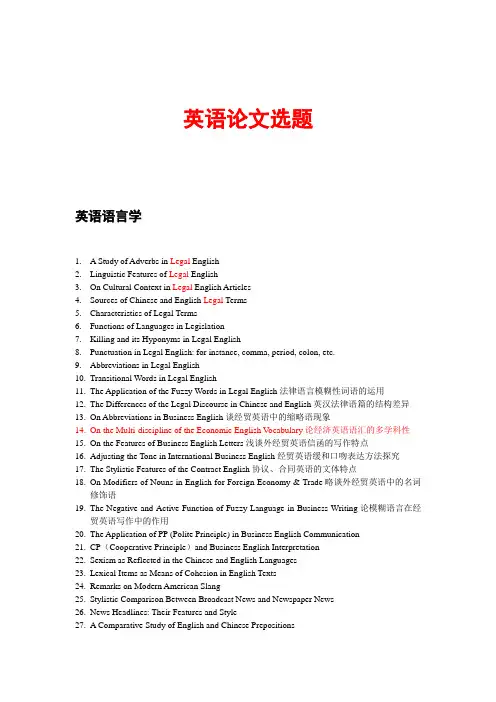
英语论文选题英语语言学1. A Study of Adverbs in Legal English2.Linguistic Features of Legal English3.On Cultural Context in Legal English Articles4.Sources of Chinese and English Legal Terms5.Characteristics of Legal Terms6.Functions of Languages in Legislation7.Killing and its Hyponyms in Legal English8.Punctuation in Legal English: for instance, comma, period, colon, etc.9.Abbreviations in Legal English10.Transitional Words in Legal English11.The Application of the Fuzzy Words in Legal English法律语言模糊性词语的运用12.The Differences of the Legal Discourse in Chinese and English英汉法律语篇的结构差异13.On Abbreviations in Business English谈经贸英语中的缩略语现象14.On the Multi-discipline of the Economic English V ocabulary论经济英语语汇的多学科性15.On the Features of Business English Letters浅谈外经贸英语信函的写作特点16.Adjusting the Tone in International Business English经贸英语缓和口吻表达方法探究17.The Stylistic Features of the Contract English协议、合同英语的文体特点18.On Modifiers of Nouns in English for Foreign Economy & Trade略谈外经贸英语中的名词修饰语19.The Negative and Active Function of Fuzzy Language in Business Writing论模糊语言在经贸英语写作中的作用20.The Application of PP (Polite Principle) in Business English Communication21.CP(Cooperative Principle)and Business English Interpretation22.Sexism as Reflected in the Chinese and English Languages23.Lexical Items as Means of Cohesion in English Texts24.Remarks on Modern American Slang25.Stylistic Comparison Between Broadcast News and Newspaper News26.News Headlines: Their Features and Style27.A Comparative Study of English and Chinese Prepositions28.Death Metaphors in English29.The Pragmatic Functions of Intonation for Language Acquisition30.The Change of English Word Meaning: Factors and Types31.A Study of Transitional Words and Expressions 过渡词及表达法的研究32.Euphemistic Expressions in Foreign Affairs 外事用语中的委婉表达33.Features of Network English 网络英语的特点34.Influence of Science and Technology on English V ocabulary 科学技术对英语词汇的影响35. Linguistic Features of Abraham Lincol n’s Addresses 论林肯演说词的语言特征36.Linguistic Features of Business Contracts 商务合同的语言特征37.Linguistic Taboos in Chinese and English Languages 谈汉英语言中的禁忌现象55. On the Functions of Ambiguity in English 论英语歧义的功能64. On the Similarities and Differences of the Speeches by Elder and Younger Bush 论老布什、小布什语言风格的异同38.Parallelism in English英语中的排比现象39.Pragmatic Failures in the Cross-cultural Communication 跨文化交际中的语用失误40.Relationship of Age to SLA (Second Language Acquisition) 论年龄与第二语言习得的关系41.Semantic Analysis of Nominalization in EST 科技英语名词化语义分析42.Analysis of the Speech Acts of Characters I Pride and Prejudice《傲慢与偏见》中人物言语行为的分析43.Lexical Relation and Their Cognitive Motivation词汇关系及其认知理据44.An Interpretation of Speech Acts in Death of a Salesman,《推销员之死》言语行为分析45.Effects of Nonverbal Communication on Daily Life 非言语交际对日常生活的影响46.浅析英汉人体隐喻的异同47.论“心”的隐喻认知系统48.从《老友记》的对话看礼貌策略使用的性别差异49.英语中法语借词的历史演变50.英语中“笑”类动词的语义成分分析51.从礼貌的视角比较英汉称赞语52.浅谈英汉中的借词差异及英语借词对汉语的影响53.死亡委婉语的应用及其文化内涵54.探索《傲慢与偏见》中的委婉语55.政治委婉语在伊拉克战争中的使用56.“死亡”委婉语变异的语境分析tin’s Influence on the English V ocabulary in the History Perspective58.The Recognition of Componential Analysis and Its Application59.模糊语的交际/语用功能分析60.The Ways of Expressing Emphatic Ideas in English 英语中强调语气的表达方式61.A study of the Code-Switching in Internet Communication 网络交际中的语码转换研究62.On Metaphors in Advertising English英语广告中的暗喻e of English abbreviations in Chinese news reports汉语新闻报道中的英语缩略语运用e of English abbreviations in Chinese advertisements汉语广告中的英语缩略语运用65.Chinese-English Code-switching in daily communication日常交际中的英汉语码转换66.Chinese-English Code-switching in net communication网络交际中的英汉语码转换67.Gender Differences in English Communication英语交际中的性别差异68.Sexism in English Proverbs英语习语中的性别歧视69.Economy Principle and Noun-Verb Shift 论语言经济原则与名词动词化70.English Abstract Nouns and Their Translation into Chinese 论英语抽象名词及其汉译71.Rules-Breaking in the Language of Advertising 论广告中的反语法规则现象72.A Comparative Study of Ambiguous Sentences in English and Chinese 英汉歧义句对比研究73.A Comparative Study of Spouse-seeking Notice in English and Chinese英汉征婚启事对比研究74.A Comparative Study of Humor in English and Chinese英汉幽默语用研究75.The Formation and Metabolism of English Euphemisms英语委婉语的构造法及其变化规律76.A Brief Research into the Deviation of Punctuation Marks& Aesthetic Value 浅议标点符号的变异使用及其审美功能77.Presupposition and its Application in Advertising 论预设及其在广告语中的运用78.Polite Principles in Business English and Their Use商务英语中的礼貌原则及运用79.An Analysis of the Characteristics of Abbreviations and Their Original Words in OnlineChatroom网络聊天室缩略语及其原词语的特点分析80.A Survey on the Non-Chinese Expressions on BBS of Chinese Universities高校网络媒体BBS 上非汉语词汇用语的调查研究81.Politeness and Business English Letters礼貌与商务英语信函82.A Historical Analysis on Constitution Particularity of American English 从历史角度简析美国英语形成的历史特殊性83.A Contrast Between Chinese and English Compliments中英称赞语对比84.Interpretation of Advertising Language from the Relevance Theory 广告语的关联理论分析85.Pragmatic Strategies in Business Negotiations商务谈判中的语用策略86.An Analysis on Ideational Function of English News 英语新闻的概念功能分析教学法87.Relationship of Age to Legal English Learning88.Legal English V ocabulary Teaching89.The Application of Schema Theory in Reading Comprehension90.Collaborative Learning: Group Work91.Cognitive Approach in Oral English Teaching92.English Songs—An Effective and Supplementary Medium of English Teaching25. Effects of Learner’s Motivation in Foreign Language Learning 外语学习中学习动机的影响27. Error Analysis in English Learning as a Foreign Language 英语学习中的错误分析研究43. Logical Fallacies in English Writing 英文写作中的逻辑谬误46. Needs Analysis of Language Learners 语言学习者的需求分析47. On Attitudes and Motivation in Second Language Learning 论第二语言学习的态度及动机93. Personality Factors to the Success of Foreign Language Learning 个性因素在外语学习中的作用94.The Cognitive and Affective Factors in Task-based English Teaching英语任务型教学中的认知和情感因素95.On the Differences between Children and Adults in the Effects of Mother Tongue on SecondLanguage Acquisition儿童和成年人在母语对二语习得影响方面的差异96.Analysis and Exploration of Oral English Teaching and Learning Method in UniversityClassroom大学课堂中对英语口语教学学习方法的分析和研究97.图式理论在英语听力教学中的应用98.图式理论及其对高中英语阅读教学的启示99.对高中英语课堂阅读现状的调查和分析100.多媒体技术在中学英语教学中运用现状的分析101.浅谈私立高中英语课堂中的师爱教学102.背诵在英语学习中的作用103.言语行为语用能力培养在英语课本中的实现——以《新概念英语》为个案104.关于英语课堂中教师反馈情况的调查分析研究105.用英语电影辅助高中英语教学106.同伴纠错在英语写作课堂中的应用107.大学英语教师课堂话语策略个案研究108.关于高中生英语学习中焦虑问题的调查研究109.论任务式英语口语教学中的合作学习110.合作学习在高中英语写作教学中的应用111.中国大学生英语写作中汉语词法的负迁移112.英语专业学生听力学习中元认知策略使用状况的调查113.语篇衔接以及写作中的衔接错误114.英汉亲属称谓语的差异及其互译115.A Study on the Elements in Improving English Listening Ability under Computer-and-Internet-Assisted Circumstance计算机网络下的英语听力能力提高的元素116.Obstacles in Understanding American English Idiomatic Statements for Chinese Students中国学生对含成语的美国英语表述理解的障碍117.On the Training of English Listening-Awareness英语听力意识的训练118.Effects of Discourse Structure on Listening Comprehension of Aural English 语篇结构对英语听力理解的影响119.Effects of Stereotypes on Intercultural Communication文化成见在跨文化交际中的影响120.The Influence of Web Technology on University English Teaching Modes / English Listening / Oral English / English Lexical Teaching 网络环境对英语教学模式/听力/口语/词汇教学的影响121.Backwash of Tests on English Teaching and Learning测试对英语教学的反拨作用122.The Differences in English Study between Boy Students and Girl Students in Senior Schools 高中男女生英语学习差异的研究文化123.Relationship between Culture and Law124.Cultural Distinctiveness in Legal English Translationparison of Chinese and English Forms of Addresses126.Hierarchies in American and Chinese Address Forms127.The Role Played by the American Blacks in the History of America128.The Cults in Modern American Society129.Chinese and Western Culture Values in Advertising Language130.Deep-structure Transfer in Cross-cultural Communication131.Cultural Differences in Nonverbal Communication132.Religious Cultural Factors Affecting the Differences of Meanings of Words133.A Comparison of Intercultural Usages between Chinese and Western Courtesy Languages 134.19. Cross-culture Failures by Chinese learners of English135.中国英语学习者跨文化交际中的误区136.The Comparison Between Taoism and Transcendentalism道家文化与超验主义的比较研究137.The comparative studies between Buddhism and Christianity on cultural level 佛教与基督教在文化层面上的对比研究138.The Sino-US Cultural Differences Reflected in Movies 看中美电影中的文化差异139.英汉数字习语文化比较140.Linguistic and Cultural Comparison between Chinese“狗”and English “dog”中西“狗”的语言文化比较研究141.中国牡丹和英国玫瑰折射出的文化差异文学142.Hamlet: His Characters as a Humanist143.Parallelism and Contrast of Shakespeare’s Dramatic Language144.On the Structure of Dickens’s Hard Times145.Jane Austen’s Art of Irony and Its Rhetoric Effects146.The High Class as Seen in Thackeray’s Vanity Fair147.From Pastoral Stories to Great Tragic Novels: An Analysis of Hardy’s Novels148.Remarks on wrence’s Psychological Analyses149.Social Reality as Reflected in the Poetry of William Blake150.Edgar Allan Poe and the World Literature151.The Tragic Color of Earnest Hemingway’s Novels152.A Critical Study of William Faulkner’s A Rose for Emily:Its Narrative Techniques and Structure153.Some Features of Steinbeck’s Literary Style154.Emily Dickinson and Her Unique Poetry155.Symbolism in O’Neill’s Major Plays156.The Modern American Society and The Death of the Salesman157.A Comparative Study of Empathy in English and Chinese Poetry158.A Comparative Analysis of Sentence Structures in English and Chinese Poetry159.The Realism of the Adventure of Huckleberry Finn160.Heroism in Hemingway’s Works161.The Light of the Dark:The Greatest Works of Conan and Agatha162.On Wordsworth’s View of Nature163.On the Symbolism of D.H. Lawrence’s The Rainbow164.Analysis of Characters of Don Quxiote165.On the Author and the Major Characters of The Pearl166.Social Reality Reflected in Ode To the West Wind167.Hamlet and His Delay168.The Cuban Culture Contest of The Old Man and the Sea169.Gothic Features in Wuthering Heights170.The Comparison of the Character of Carrie Meeber and Jennie Gerhardt171.The Philosophy of Life in Ernest Hemingway’s The Old Man and the Sea172.Mark Twain---The Pessimist Who Brought Laughter to The World173.Humor and Realism of Mark Twain’s The Celebrated Jumping Frog of California County 174.Robinson Crusoe and the Colonial Empire175.A Probe into the Ambiguity and Symbolization of Eliot’s Poetry176.The Realism of Adventure of Huckleberry Finn177.A Farewell to Arms—A Clear Mirror178.Gone with the Wind and the Awakening of Women179.Hemingway and Hemingway Heroes180.The Sound of Heart-Reverie and Melancholy in Emily Dickinson’s Poemsment on the Biblical Images in Paradise Lost, Paradise Regained, Samson Agonistes parison of Gone with the Wind and The Collector—An Analysis of Women’s Problem 183.Satire in Catch—22184.Love, Equality and Tolerance—On the Nature of Love of Jane and Tess185.On the Endings and Features of O ·Henry's Short Stories186.Paradise Lost—The War in the Heaven187.The Attractions of The Waste Land188.On the Religious Color of Characterization in Uncle Tom's Cabin189.Thoreau's Walden: A Book of Inward Exploration190.Beautiful Women—Analysis of Female Characters in The Merchant of Venice191.The Great Gatsby and the Collapse of the American Dream192.The Influence of Edgar Allan Poe's Life on his Writing193.The Biblical Allusions and Symbols in The Grapes of Wrath194.A Journey of Outward and Inward Exploration—A Brief Analysis of Walden195.The Duality in Robinson Crusoe's Character196.On the Characterization and Writing Techniques in Rebecca197.Wordsworth: Nature's Favorite Son198.Two Aspects Reflected from Robinson Crusoe: Society and Nature199.The Superman Complex in Love of Life200.3. A Comm ent on Hardy’s Fatalism 评哈代的宿命论201.4. A Comparison between the Themes of Pilgrimage to the West and Pilgrim’s Progress 202.《西游记》与《天路历程》主题的比较203.49. On T.S. Eliot’s Mythological Consciousness 论艾略特的神话意识204.On the Tragedy of Loman’s Family in Death of A Salesman 《推销员之死》中罗曼一家的悲剧205.Points of View and the Mode of Discourse in Vanity Fair 论《名利场》的观点及言语方式206.Rhetorical and Narrative Devices in A Farewell to Arms 《永别了,武器》的修辞与描写手法207.Scarlet and Black in The Scarlet Letter 《红字》中的红与黑208.Robinson Crusoe--Representative of the New Capitalist鲁滨逊—新兴资产阶级的代表209.The Women World in The Thorn Birds---Same World,Different Destiny《荆棘鸟》中的女性世界---同一世界, 不同命运210.The Transformation of Buck in The Call of the Wild小说《野性的呼唤》中巴克的转变211.Rebecca Sharp---The Real Heroine in Vanity Fair丽蓓卡·夏泼---《名利场》的真正主人公212.The Conflict between Greed and Human nature ---- on An American Tragedy从《美国悲剧》看贪婪与人性的冲突213.What is Small and What is Big in Great Expectations《远大前程》中的“大”与“小214.A Contrastive Study between "White" and "Black" in The Adventures of Huckleberry Finn 《哈克贝利·费恩历险记》中“白”与“黑”的对比研究215.Black Humor in Catch-22《第二十二条军规》中的黑色幽默216.A Contrastive Study of the Influence of Religion upon Tess and Prynne宗教对苔丝和白兰命运的影响的对比分析217.On Symbolism in Lord of the Flies 象征手法在《蝇王》中的运用218.Analysis of Christianity Theme on The Name of the Rose《玫瑰之名》的宗教主题分析219.Christianity in Uncle Tom's Cabin小说《汤姆叔叔的小屋》中的基督教220.On the Intercultural Conflicts in The Portrait of a Lady《贵妇画像》中跨文化冲突的分析221.On the Theme of Struggle for Survival in Sister Carrie Base on the Character Analysis从人物分析研究《嘉莉妹妹》中人们为生存挣扎的主题222.An Analysis of Scarlett's Intelligence and Capability in Gone with the Wind论小说《飘》中斯佳丽的智慧和能力223.An Analysis of the Image of "Hunter" in Moby-Dick and The Old Man and the Sea《白鲸》和《老人与海》中的“猎者”形象分析224.Naturalism in Sister Carrie by Theodore Dreiser德莱塞《嘉莉妹妹》的自然主义解析225.On the Meaning of Symbols in Beloved析《宠儿》中的象征意义226.Individuality, the Limitation of Ideology and Symbolism in Invisible Man浅析《看不见的人》中的自我个性,意识形态局限性和象征主义227.Female Image Comparison between Scarlett and Meggie斯佳丽与梅吉的女性形象比较228.A Study of Invisible Man from An Existential Perspective从存在主义视角看《隐形人》229.A Feminist Study of the Effect of American Civil War upon the Female World in American Society Seen from Gone with the Wind 从女权主义视角看<<飘>>所反映的美国内战对美国女性世界的影响230.A Social Cultural Contrastive Stuy of Scarlett O'Hara and Wang Xifeng郝思佳和王熙凤的社会文化对比研究231.The Marriage of Mr. Collins and Charlotte Lucas in Pride and Prejudice《傲慢与偏见》中柯林斯与夏洛蒂•卢卡斯的婚姻232.Miserable World in the Humor---A Comparison of the Works of Mark Twain and O. Henry幽默中的悲惨世界---马克吐温和欧亨利作品的比较233.A Comparison of Conflicts in Desire Under the Elms and Thunderstorm《榆树下的欲望》和《雷雨》戏剧冲突的比较234.The Art of Satire in Gulliver's Travels论《格列佛游记》中的讽刺艺术235.Acomparative Study of Abbie and Fanyi in Desire Under the Elm and Thunderstorm<榆树下的欲望>和<雷雨>中爱碧和繁漪的对比研究236.Exotic Flowers in East and West —Comparison between Romeo and Juliet and Liang Shanbo and Zhu Yingtai(中西方的艺术奇葩——比较《罗密欧与朱丽叶》与《梁山伯与祝英台》)237.An Elegy of Humanism—An Analysis of the Causes of The Tragedy of Othello(人文主义的悲歌——《奥赛罗》悲剧成因之探析)238.A Comparison between the Themes of Pilgrimage to the West and Pilgrim’s Progress 《西游记》与《天路历程》主题的比较239.A Comparative Study of Tao Yuan-Min and William Wordsworth240.The Images of the West Wind in Shelley’s Ode to the West Wind 雪莱《西风颂》中西风的意象241.Ode to a Nightingale: An Integration of Aesthetics and politics<夜莺颂》诗歌美学与政治意识的结合242.A Contrastive Study of Images in English and Classical Chinese Poems英诗和中国古典诗歌中的意象比较243.Five Natural Elements in Wordsworth’s Poems华兹华斯诗中的五种自然元素翻译理论与实践244.Translation of Complex Sentence in the Legal Language245.The Influence of Cultural Elements on the Translation of the idioms in Commercial English 试论文化因素对经贸领域中习语翻译的影响mercial English: its characteristics and translation经贸英语的特点与翻译247.The Characteristics of Business Contract Wording in English & its Translation英语经贸契约的用词特点与翻译248.On the Usage and Translation of Prepositions and Prepositional Phrases in Business Contracts in English英语经贸契约介词和介词短语的用法及翻译249.Understanding and Translation of the Divisional Phenomena in English Economic Contracts 英语经贸契约分隔现象的理解与翻译250.Lexical Features of Business Contract English and Its Translation经贸合同英语词法特征及其翻译251.Characteristics and Distinctive English Translation of Words in Business Contracts商务合同英语用词特点及翻译的特色标记252.The Characteristics and the Present Situation of Foreign trade English Translation对外经贸翻译的特点与现状253.On the Translation of Commercial Advertisement谈商业广告的翻译254.On the Role of Social Context in Business English Translation浅议经贸英语翻译中语境因素的作用255.On the Criteria of Translating English in to Foreign- oriented Economy and Trade Affairs试论经贸英语翻译的标准256.Translation Characteristics of Economy and Trade English经贸英语的翻译特点257.Understanding and Translation of the Divisional Phenomena in English Economic Contracts 英语经贸契约分隔现象的理解与翻译258.On the Strategies of the Mistranslation in Business English论经贸英语误译的对策259.Multi-angle Views On Business English Translation经贸翻译的多视角260.A Classification & Translation of Words Denoting Major Positions in Business English经贸英语中主要职务用词的分类与翻译261.The Classification and Translation of the Business English Terms with the Reference of "Money"经贸英语中含有"钱款"意义词汇的分类及翻译262.Word Diction in Economy and Trade Translation经贸翻译的词义选择263.On Translation of English Advertisement广告英语的翻译264.Advertisement English Translation in Cross-cultural Background跨文化背景中的广告英语翻译265.On Translation of the Dates, Amount and Numbers (Figures) in the Economic & Trade Contracts经贸契约中日期、金额和数字的翻译266.Translating Strategy of Modern Business English现代商务英语翻译策略267.Methods and Principles of Trade Mark Translation商标翻译的方法及应遵循的基本原则268.The Language Characteristics and Translation Stragegy of English Advertisements广告英语语言特点及其翻译策略269.How to Correctly Understand & Translate the Compound Words Formed from Here-, There- and Where- in Economic & Trade Contracts 如何正确理解和翻译经贸契约中Here,There-和Where构成的复合词270.On the Rhetoric Character and Translating Method of Advertising English浅析广告英语的修辞特点和翻译方法271.On Metaphors in Business English and Translation商务英语中的隐喻及其翻译272.On "Faithfulness" and "Innovation" in Foreign Trade English Translation外贸英语翻译的"忠实"与"变通"273.The Stralegies of Domestication and Dissimilation on Advertising English Translation广告英语翻译的"归化"和""异化"策略274.Cross-cultural and Cross-linguistic Factors in English Advertisement Translation英语广告翻译中的跨文化、跨语言因素275.Nominalization application in business English letter writing and its translation名词化结构在商务英语信函中的应用和翻译276.On the Art of Rhetoric and Translation Approaches in Advertising English论广告英语的修辞艺术和翻译方法277.Principles of Translating Economic Literature of Enterprises from Chinese to English企业外宣资料汉英翻译原则278.English-Chinese Translation of Trademarks: Its Principles and Strategies英语商标的汉译原则及策略279.The Puns in English and Chinese Advertisements and the Translation of Them英汉广告中的双关语及其英汉互译280.The Pragmatic Analysis and Translation Strategies of Long Sentences in English Business Contracts英语商务合同长句的语用分析及翻译策略281.Influence of Cultural differences on the Chinese-English Translation of Business Writing文化差异对商务汉英翻译的影响282.On Equivalence of Cultural Message in the International Business English Translation国际商务英语翻译中的文化信息等值研究283.On the Principles of Equivalence in Literary Translation284.Cultural Gaps and Untranslatability285.The Chinese V ersion of Jude the Obscure: An Outstanding Example of Artistic Recreation 286.Translating the Style of Literary Works—A Preliminary Study of Wu Ningkun’s Version of The Great Gatsby287.A Comparative Study of Two Chinese Versions of The Merchant of Venice288.A Reading of Fang Zhong’s Translation of The Canterbury Tales289.On the English Versions of Some of Du Fu’s Poems290.Translating the Titles of Chinese Classic Poetry291.How to Deal with Ellipsis in Translating292.The Translation of Trade Marks and Culture293.Onomatopoeia and its Translation294.On the Cross-Culture Pragmatic Failure in English Translation295.On Translating the Passive Voice in Scientific and Technology English into Chinese296.A Comparative Study of Two English Version of the Chang Ganxing297.Review on the Translation of Movie Titles298. A Study of the Translation of Sports Terms 体育专有名词的翻译299. About Transform of Parts of Speech in Translation 论翻译中词性的转换300.On Translation of Computer Terms 论计算机的术语翻译301.On Translation of Tourist Guide 论旅游指南的翻译302. On Translation of Trade Names and Names of Export Commodities 论商标、出口商品名称的翻译303.The Understanding and Translation of Attributive Clause 定语从句的理解与翻译304.On the Translation of Long Sentences and Attributive Clauses in A Tale of Two Cities浅析《双城记》中长句与定语从句的翻译技巧305.The Understanding and Translation of Attributive Clause 定语从句的理解与翻译306.Differences Between Chinese Headline and English Headline as well as Their Translation 论中英文新闻标题的差异与翻译307.On Brand Name Translation Strategies from the View of Consumer Psychology从消费心理学角度浅谈商标翻译策略308."Fu Donghua’s Gone With the Wind and Functional Translation Theory 傅东华的《飘》和功能翻译理论309.The Subjectivity of the Translator in Literary Translation 文学翻译中的译者主体性310.Cultural Differences and Transplantation in Translation文化差异和翻译中的文化移植311.Idioms’Practice and Translation in Advertising 习语在广告中的应用与翻译312.On the Impact of Translation on Chinese Culture--- To Cherish Chinese Culture 翻译对中国文化的影响--- 保护中国文化313.A Comparative Study of Two English Versions of One of Tao Yuanming’s Set Poems Drinking Wine 对陶渊明《饮酒》组诗之一的两个英译本的比较研究314.论儿童文学的翻译315.例析俚语的英译汉316.。
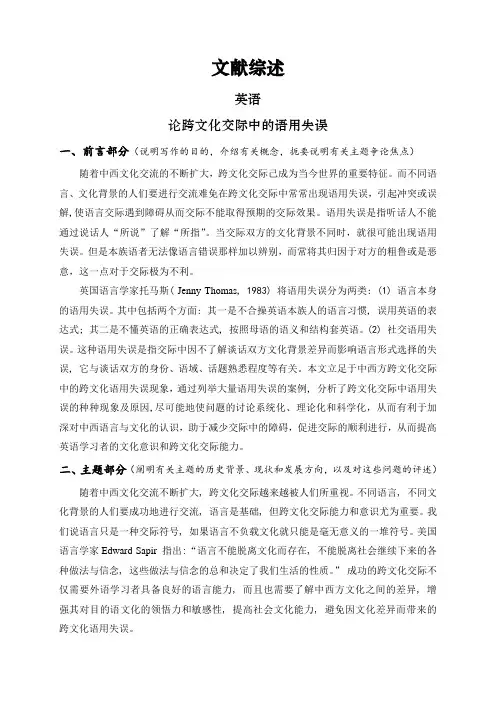
文献综述英语论跨文化交际中的语用失误一、前言部分(说明写作的目的,介绍有关概念,扼要说明有关主题争论焦点)随着中西文化交流的不断扩大,跨文化交际己成为当今世界的重要特征。
而不同语言、文化背景的人们要进行交流难免在跨文化交际中常常出现语用失误,引起冲突或误解,使语言交际遇到障碍从而交际不能取得预期的交际效果。
语用失误是指听话人不能通过说话人“所说”了解“所指”。
当交际双方的文化背景不同时,就很可能出现语用失误。
但是本族语者无法像语言错误那样加以辨别,而常将其归因于对方的粗鲁或是恶意,这一点对于交际极为不利。
英国语言学家托马斯( Jenny Thomas, 1983) 将语用失误分为两类: (1) 语言本身的语用失误。
其中包括两个方面: 其一是不合操英语本族人的语言习惯, 误用英语的表达式; 其二是不懂英语的正确表达式, 按照母语的语义和结构套英语。
(2) 社交语用失误。
这种语用失误是指交际中因不了解谈话双方文化背景差异而影响语言形式选择的失误, 它与谈话双方的身份、语域、话题熟悉程度等有关。
本文立足于中西方跨文化交际中的跨文化语用失误现象,通过列举大量语用失误的案例, 分析了跨文化交际中语用失误的种种现象及原因,尽可能地使问题的讨论系统化、理论化和科学化,从而有利于加深对中西语言与文化的认识,助于减少交际中的障碍,促进交际的顺利进行,从而提高英语学习者的文化意识和跨文化交际能力。
二、主题部分(阐明有关主题的历史背景、现状和发展方向,以及对这些问题的评述)随着中西文化交流不断扩大, 跨文化交际越来越被人们所重视。
不同语言, 不同文化背景的人们要成功地进行交流, 语言是基础, 但跨文化交际能力和意识尤为重要。
我们说语言只是一种交际符号, 如果语言不负载文化就只能是毫无意义的一堆符号。
美国语言学家Edward Sapir指出:“语言不能脱离文化而存在, 不能脱离社会继续下来的各种做法与信念, 这些做法与信念的总和决定了我们生活的性质。
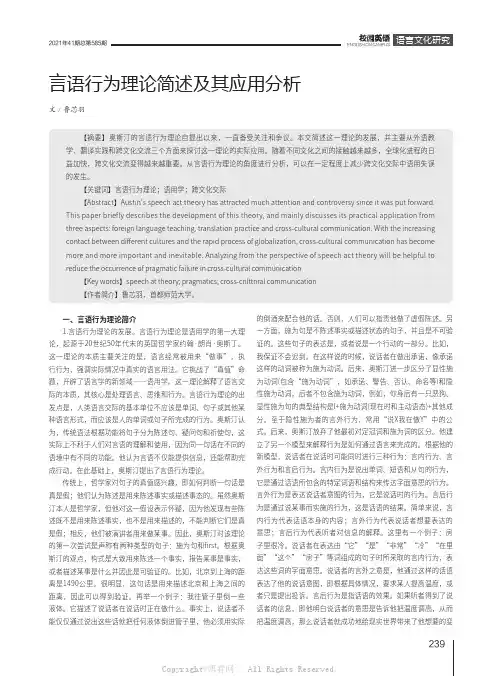
2021年41期总第585期ENGLISH ON CAMPUS【摘要】奥斯汀的言语行为理论自提出以来,一直备受关注和争议。
本文简述这一理论的发展,并主要从外语教学、翻译实践和跨文化交流三个方面来探讨这一理论的实际应用。
随着不同文化之间的接触越来越多,全球化进程的日益加快,跨文化交流变得越来越重要。
从言语行为理论的角度进行分析,可以在一定程度上减少跨文化交际中语用失误的发生。
【关键词】言语行为理论;语用学;跨文化交际【Abstract】Austin's speech act theory has attracted much attention and controversy since it was put forward. This paper briefly describes the development of this theory, and mainly discusses its practical application from three aspects: foreign language teaching, translation practice and cross-cultural communication. With the increasing contact between different cultures and the rapid process of globalization, cross-cultural communication has become more and more important and inevitable. Analyzing from the perspective of speech act theory will be helpful to reduce the occurrence of pragmatic failure in cross-cultural communication【Key words】speech at theory; pragmatics; cross-cnlttnral communication【作者简介】鲁芯羽,首都师范大学。
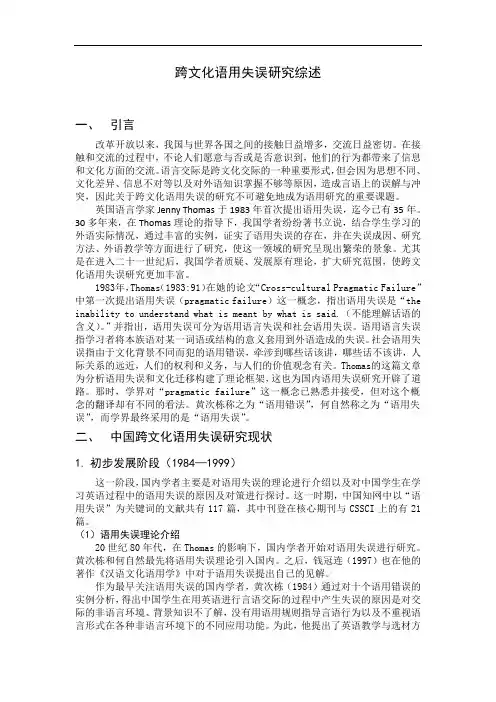
跨文化语用失误研究综述一、引言改革开放以来,我国与世界各国之间的接触日益增多,交流日益密切。
在接触和交流的过程中,不论人们愿意与否或是否意识到,他们的行为都带来了信息和文化方面的交流。
语言交际是跨文化交际的一种重要形式,但会因为思想不同、文化差异、信息不对等以及对外语知识掌握不够等原因,造成言语上的误解与冲突,因此关于跨文化语用失误的研究不可避免地成为语用研究的重要课题。
英国语言学家Jenny Thomas于1983年首次提出语用失误,迄今已有35年。
30多年来,在Thomas理论的指导下,我国学者纷纷著书立说,结合学生学习的外语实际情况,通过丰富的实例,证实了语用失误的存在,并在失误成因、研究方法、外语教学等方面进行了研究,使这一领域的研究呈现出繁荣的景象。
尤其是在进入二十一世纪后,我国学者质疑、发展原有理论,扩大研究范围,使跨文化语用失误研究更加丰富。
1983年,Thomas(1983:91)在她的论文“Cross-cultural Pragmatic Failure”中第一次提出语用失误(pragmatic failure)这一概念,指出语用失误是“the inability to understand what is meant by what is said.(不能理解话语的含义)。
”并指出,语用失误可分为语用语言失误和社会语用失误。
语用语言失误指学习者将本族语对某一词语或结构的意义套用到外语造成的失误。
社会语用失误指由于文化背景不同而犯的语用错误,牵涉到哪些话该讲,哪些话不该讲,人际关系的远近,人们的权利和义务,与人们的价值观念有关。
Thomas的这篇文章为分析语用失误和文化迁移构建了理论框架,这也为国内语用失误研究开辟了道路。
那时,学界对“pragmatic failure”这一概念已熟悉并接受,但对这个概念的翻译却有不同的看法。
黄次栋称之为“语用错误”,何自然称之为“语用失误”,而学界最终采用的是“语用失误”。
跨文化交际中的语用失误以及有效应对策略摘要:随着中国改革开放程度的逐渐深入,跨国域、跨民族、跨文化的经济和社会交往与日俱增,不同国家和地区的人们在相互交往的过程中不可避免地会出现文化冲突现象。
语用失误不是来自语言本身的语法错误,而是说话人用词不当或听话人误解了说话人的意图所致。
更多的语用失误则是由于谈话双方不了解对方的文化背景、风俗、禁忌、价值观念等造成的。
通过对跨文化交际中常见的语用失误进行分析,提出了减少语用失误的对策。
关键词:跨文化交际;语用失误;文化一、跨文化交际与语用失误跨文化交际是指不同文化背景的人们之间的交际活动。
人进行言语交往时都要受到文化背景的影响,交际双方的交流就是依赖于两种文化背景的人运用不同的语言进行交往。
当编码与解码不在同一语言文化模式下进行,这种跨文化交际就会形成不同形式的语用失误。
在人们的言语交际中,因未达到完满的交际效果而出现的差错,统称为“语用失误”。
在这里,我们不用“错误”,而是采用“失误”这一说法,这是因为,语言失误并不是语言本身的语法错误所引起的,它不是因语法结构出现错误而导致的词不达意。
语用失误是说话人采取的说话方式不合时宜或者不符合表达习惯。
根据英国著名语言学家jenny tommas的观点,可以将语用失误分为两种:语用语言失误和社交语言失误。
它们均是跨文化语用学的重要组成部分。
顾名思义,语用语言失误是因不同语言之间的差异和它们之间的影响所引起的,很多情况下,这种失误也应归因于母语对第二语习得过程中的干扰。
而社交语言失误是由不同语言所依赖的文化背景差异或者社交文化习惯引起的,这就是说,当说话者对对方缺乏文化了解,情急之下,运用母语的文化习惯进行会话就会形成语用失误。
二、跨文化交际中语用失误的表现及其产生的原因1.跨文化交际中语用失误的表现(1)语用语言失误语用语言失误指的是由于外语学习者不懂得目的语的语言习惯,而把母语的语言习惯运用到目的语中,而造成表达的不准确,例如:a:thank you very much.b:never mind.在上述的对话中,b用“never mind”来表达不用谢的意思是不对的,当我们对对方道歉时表示不介意时才会用“never mind”。
跨文化交际中的语用失误现象及解决策略
跨文化交际是海外留学、国际经贸往来和国际交往活动中个人与企业之间进行文化交
流和关系构建的核心活动,其中不可避免地会发生语用失误。
语用失误是指说话者在口头
交流时除了出现语法错误外,还会出现由于漏result习不熟悉或不能恰当理解对方所使
用的不同语言所导致的话语理解错误现象。
语用失误通常表现为双方因为文化的差异或语
言的障碍而出现的不同看法,有时会引发误会。
首先,要准确了解不同文化背景下人们的想法,双方需要通过沟通了解彼此的文化和
语言。
其次,双方要学会用英语问题和自然,有时要根据地域和历史背景进行表达。
有些
话可能在一个文化中可以容易地理解,但在另一个文化中可能会被误解。
此外,双方要进
行多方面的练习,提高口头表达能力,努力减少不必要的歧义和语法错误,增强交流能力。
最后,双方还应该针对碰到的困难,其中一方应该尝试帮助另一方理解,或者利用异族平
台等资源来协助彼此理解。
总之,跨文化交流中出现的语用失误现象双方可以采取正确恰当的措施和策略,在沟
通环节中谨慎表达,积极控制自身的文化屏障,为交流搭建良性的心态环境,克服语言的
障碍,提高文化意识,改善跨文化交流。
准确的理解是交流的基石,希望双方共同努力,
有效的控制语用失误的发生,以实现和谐的友好沟通。
跨文化语用失误研究综述一、引言改革开放以来,我国与世界各国之间的接触日益增多,交流日益密切。
在接触和交流的过程中,不论人们愿意与否或是否意识到,他们的行为都带来了信息和文化方面的交流。
语言交际是跨文化交际的一种重要形式,但会因为思想不同、文化差异、信息不对等以及对外语知识掌握不够等原因,造成言语上的误解与冲突,因此关于跨文化语用失误的研究不可避免地成为语用研究的重要课题。
英国语言学家Jenny Thomas于1983年首次提出语用失误,迄今已有35年。
30多年来,在Thomas理论的指导下,我国学者纷纷著书立说,结合学生学习的外语实际情况,通过丰富的实例,证实了语用失误的存在,并在失误成因、研究方法、外语教学等方面进行了研究,使这一领域的研究呈现出繁荣的景象。
尤其是在进入二十一世纪后,我国学者质疑、发展原有理论,扩大研究范围,使跨文化语用失误研究更加丰富。
1983年,Thomas(1983:91)在她的论文“Cross-cultural Pragmatic Failure”中第一次提出语用失误(pragmatic failure)这一概念,指出语用失误是“the inability to understand what is meant by what is said.(不能理解话语的含义)。
”并指出,语用失误可分为语用语言失误和社会语用失误。
语用语言失误指学习者将本族语对某一词语或结构的意义套用到外语造成的失误。
社会语用失误指由于文化背景不同而犯的语用错误,牵涉到哪些话该讲,哪些话不该讲,人际关系的远近,人们的权利和义务,与人们的价值观念有关。
Thomas的这篇文章为分析语用失误和文化迁移构建了理论框架,这也为国内语用失误研究开辟了道路。
那时,学界对“pragmatic failure”这一概念已熟悉并接受,但对这个概念的翻译却有不同的看法。
黄次栋称之为“语用错误”,何自然称之为“语用失误”,而学界最终采用的是“语用失误”。
跨文化交际的语用失误研究A Study of Pragmatic Failure in Intercultural Communication摘要本论文尝试从一些基本的语用学理论入手对比分析不同文化差异引起的语用失误现象,以便从更科学和系统的角度了解不同文化、不同社会、不同群体的人们是如何以不同的标准来进行他们各自的言语行为。
本文重点从言语交际失误方面展开对语用失误的研究,主要包括语用语言失误和社交语用失误两种。
并且通过对这两种语用失误的分析,作者提出了一些针对语言教学的启示。
关键词: 跨文化交际;文化差异;语用语言失误;社交语用失误;语言教学启示AbstractThis thesis attempts to analyze pragmatic failure according to some basic pragmatic theories, in order to understand people more scientifically and systematically who come from different culture, society and community how to operate interaction based on different standards. The thesis will emphasize on verbal communication which concludes pragmalinguistic failure and socio-pragmatic failure. And through analyzing on the two kinds of pragmatic failures, the author puts forward some enlightenment for language teaching.Key words: Intercultural Communication; Cultural Differences; Pragmalinguistic Failure;Socio-pragmatic Failure; Enlightenment for Language TeachingChapter One IntroductionIntercultural communication activities go with the history of mankind, but as a subject it only emerged several decades ago and a great many researches from different perspectives have been conducted on it by scholars at home and abroad. The thesis attempts to make analysis on the pragmatic failures in the intercultural communication from the view point of sociolinguistics and pragmatics.Chapter two explains several important issues. The first is to give the definition and characteristics of culture and communication, which lead to the conclusion that culture, communication and language are inseparable. The second is an overview of intercultural communication. The study of intercultural communication is a multi-discipline, and it compasses every aspect of communication.Chapter three discusses two types of pragmatic failure in verbal-communication, namely: pragmalinguistic failure and sociopragmatic failure. In terms of pragmalinguistic failure, failures in lexicon and grammar are illustrated; in terms of sociopragmatic failure, failures in what to say and how to say.Chapter four gives some enlightenment to improve language teaching approaches and concepts. In recent years, researchers have made great efforts to improve foreign language teaching, and it is thought that the pragmatic competence of foreign language learners has been improved a lot. However, pragmatic failure still haunts the language learners and teachers because it is closely concerned with culture, communication and language, which are indispensable in academic and social life.Chapter Two A Brief Survey of Some Specified Issues in InterculturalCommunication2.1 The Definitions of Classroom Questioning2.1.1 CultureCulture is such a vast and large concept that it is hard and difficult to give an exact definition that is accepted by all people. It is said that there have been at least over 150 definitions about culture, but none of them can cover all the aspects of culture. The following definitions are some of the well-known ones.Edward T. Hall gave a detailed descriptio n as “Culture is man’s medium; there is not one aspect of human life that is not touched and altered by culture. This means personality, howpeople express themselves, including shows of emotion, the way they think, how they move, how problems are solved, how their cities are planned and laid out, how transportation systems function and are organized, as well as how economic and government systems are put together and function.”(Hall, 1959, p.97)Bates and Plog proposed a descriptive definition “Culture is a system of shared beliefs, values, customs, behaviors, and artifacts that the members of a society use to cope with their world and with one another, and that are transmitted from generation to generation through learning. This definition includes not only patterns of behavior but also patterns of thought, artifacts, and the culturally transmitted skills and techniques used to make the artifacts.” (Bates & Plog, 1990, p.152)From the above definitions, we have seen culture is ubiquitous multidimensional, complex, and all-pervasive. In many ways, Hall is correct: culture is everything and everywhere (Samovar & Porter, 2000, p.34). For the purpose research on pragmatic failure in intercultural communication, the author would like to understand culture as a particular way to satisfy human’s basic needs. According to a psychologist Abraham Maslow, human being shares five basic needs: the physiological needs, the safety needs, the belongingness needs, the esteem needs and the self-actualization needs. The five basic needs of human being are shaped and affected unconsciously by culture and gradually we take it for granted and treat them as cultural-rooted habits. Take food as an example, people from one culture might think the food eaten by another cultural group is not delicious and even disgusting. Just like Chinese think it good for health to eat dog meat, while the thought of eating dog disgusts western people because dogs are treated as people’s best friend s in their culture. But no matter how different culture has its ways of doing things in daily life, it cannot be simply judged by the right-or-wrong question. It is interpreted as different people do the same things in different manners.2.1.2 CommunicationThe word “communicate” originate from the Latin word “commonis” that means “common”. So the premise of communication is that the participants should share the common knowledge. As is the case with culture, communication is complex and multidimensional. When people decode the signal and obtain the message, it is important for them to interpret messages in terms of cultural orientation. And Samovar defines communication as “it happens whenever meaning is attributed to behavior or to the residue of behavior” (Samovar, 1981, p.75). His definition tells us communication can go on through our conscious or unconscious, intentional or unintentional behavior. People are communicating everywhere all the time in various manners for different purposes.In order to clarify how communication actually operates, there are several characteristics ofcommunication need to be fully understood. First, communication is changing all the time. During the process of communication, participants are unconsciously affected by the input of new messages. So, there will be changed in some way, which means everyone will be a dynamic individual in his whole life. Second, communication is irreversible. Once messages are received and decoded it is impossible to eliminate the result and the sender’s only choice is to modify or implement the former messages. Therefore, once pragmatic failures occur in the process of communication it is not an easy job to erase some negative results and influences completely. Therefore, the study of pragmatic failure will be helpful to minimize misunderstanding in international communication.2.2 Intercultural Communication2.2.1 Definition of Intercultural CommunicationIt is an undeniable fact that we live in a global village nowadays. Intercultural communication occurs every day with the rapid economic and cultural development of society. It involves the interaction of cultures from different nations. As an independent subject, intercultural communication only emerged a few decades ago. Hall put forward the term intercultural communication first in his book The Silent Language. It can be simply defined as interpersonal communication between members of different cultures. The term has been expressed in many ways, such as intercultural communication, cross-cultural communication, the study of intercultural communication, and the study of cross-cultural communication. Among them, intercultural communication and cross-cultural communication are more widely adopted. Though the term cross-cultural communication was adopted earlier by scholars, now the former receives more preference.In many cases, intercultural communication and cross-cultural communication are understood as being the same. The study of intercultural communication is generally considered to include cross-cultural communication. According to Samovar, & Porter, intercultural communication is communication between people whose cultural perceptions and symbol system are distinct enough to alter the communication event. According to Gudykunst and Kin, intercultural communication is a comparison of some phenomena across cultures, but cross-cultural communication is an interaction between people from different cultures. They hold that intercultural communication puts emphasis on the study, while cross-cultural communication in the interaction. In this thesis, hereby, the author will adopt the term intercultural communication.2.2.2 An Overview of Intercultural CommunicationThe study of intercultural communication can be traced back to America in the late 1950s and the early 1960s. As a new world for Europeans, Asians, and people from other continentswho want to realize their American dreams, America attracts millions of immigrants all over the world. These immigrants brought not only their skills, but their cultures as well. Therefore, as a melting pot of immigrants, a variety of barriers, conflicts, and frictions due to cultural differences in communication activities arose in America. This phenomenon aroused much interest in the western countries, especially in America. Communication specialists became interested in the subject of communication among members of different cultures. The book The Silent Language is often considered as the initial signal of intercultural communication studies. From then on, anthropologists, socio-psychologists, sociolinguists have devoted with great enthusiasm to the study from a variety of perspectives.Intercultural communication was delivered as a course in some American universities in the late 1960s. With the trend of globalization, the development of intercultural communication is consistent with that of the world’s economic and cultural situations and it is more appealing not only to the specialized scholars but to any people who may engage in intercultural communication activities.Many Chinese scholars have devoted to the field and made a great many valuable researches into the study from 1980s. It is believed that intercultural communication has connection with many other subjects. Among them, anthropology, socio-psychology and socio-linguistics and communication are the most influential subjects. Jia Yuxin considers philosophy and racial interaction should be added to it. The study of intercultural communication is a multi-discipline, and it compasses every aspect of communication.Chapter Three The Pragmatic Failure in Communication3.1 Pragmalinguistic FailureThe scholar Hong Gang thinks that pragmalinguistic failure occurs when the speaker uses the utterance which is systematically different from the target language to express the same pragmatic function. In other words, the speaker violates the rules of target language and transfers norms of the source language. In this part, the author will categorize it into two aspects: lexical level and grammar level.3.1.1 Lexical LevelIn intercultural communication, it can be found that a great deal of words have the same conceptual meaning while their associative meanings are different. For example, the words of color have different associative meanings in the west and the east. The sight of color would arouse human’s emotion, and even affect our physical feeling. It seems that human shares some common responses to some colors. Such as, red represents blood and fire, the symbol of life andstrength; green is associated with freshness because it is the color of grass and tree; black is an unlucky color, related with evil, death, mourning and the underground world. In most cases, however, people’s understanding of color terms is different. In China, from the Tang dynasty the color of bright yellow was used specially by royal power, dignity and nobility. While in the Bible, Jesus wears a family, purple robe during the Passion. For the reason, the color of purple is regarded as holy, noble, equal with the color of bright yellow in China. So there are those expressions in English:be born in the purple(生在官宦之家)be raised to the purple(升为红衣主教)marry into the purple(嫁到显贵之家)It is acknowledged that there is no absolute cultural universal or cultural similarity. The confusing phenomenon is that one aspect or element in one culture is so peculiar that a counterpart or an equivalent cannot be found in another culture. For instance, the plant of bamboo plays an important role in Chinese daily life from the ancient time, being the material of boats, books, shoes and etc. The traditional culture associates bamboos with the traits of integrity, strong-minded and dignity. On the contrary, in the western culture bamboo is just a name for that kind of plant without any extending meaning. Even the word “bamboo” is borrowed from another language. Another example concerns the use of “tiger” and “dragon”. When the Chinese refers to the four developed areas in Asia they use “four dragons”. However,in English newspapers and magazines those four places are referred to as “four tigers of A sia”. In Chinese culture, dragon is a holy animal, symbolizing power and royalty. Hence, Chinese are proud of calling themselves the descendents of the dragon. However, according to Christianity, dragon is a creature of ill omen, just like the serpent in the Garden of Eden that induces Eden and Eve to break the rule and eat the evil fruit. So the Chinese idiom“望子成龙”is translated as “wish one’s child to be somebody”. Otherwise, the literal translation is unacceptable as it may bring about different cultural association. From the above example, we have learned that the associative meanings of English words are not equal with that of Chinese words. Neglecting the differences will lead people to bring their original values and attitudes into the process of intercultural communication. It is one of the most common failures resulting from inappropriate understanding of associative meanings of words.3.1.2 Grammar LevelThe shared knowledge of grammar ensures the smooth progress of effective communication. But actually, people are usually apt to employ the grammar rules of their source language unconsciously, which makes it possible for listeners to interpret speakers’ utterance in the wrong way.In Chinese, the position of adverbial modifier is comparatively stable—at the front of verb. We can read the sentence:他在安安静静地读书;他突然大笑起来。
中文标题跨文化语用失误及对策研究-以电影《安娜与国王》为例英文标题A Study of Pragmatic Failure in Intercultural Communication—With Movie Anna and the King as an Example中文关键词语用失误;文化冲突;语用负迁移;文化意识英文关键词Pragmatic failure; Cultural conflict;Negative pragmatic transfer; Cultural awareness中文摘要国内外经济的发展和整个世界的一体化,使得我们和世界各国的交流越来越频繁,这其中文化的交流更是不可避免。
由于人们的文化背景不同,在跨文化交际的过程中就很有可能引起误解甚至冲突,最终导致交际的中断和失败。
交际者深受其本族文化的影响,往往会把本民族的文化规约和语言知识带入交际行为,这就无法正确的表达自己的想法和理解对方的意图,交际失误就此产生。
本文旨在通过对跨文化语用失误的分析去寻求解决问题的办法。
跨文化交际学就是研究不同文化背景的人在交际过程中的矛盾和问题并提出解决办法的学科,并增强人们的文化意识和减少文化交流中的冲突。
本文从跨文化交际的角度出发,通过对美国电影《安娜与国王》中的文化冲突进行分析,指出文化是交际中不可忽视的重要因素。
文化的巨大差异所导致的种种矛盾,正是跨文化语用失误的体现。
片中男女主角最终克服困难,互相融入对方的文化和习俗,使得文化的交锋圆满收场。
论文由导论、正文和结论三部分组成。
导论主要介绍本文的写作目的、意义、以及电影的介绍。
正文首先对跨文化交际中常见的概念进行回顾,比如文化、交际、语用学和语用失误等重要概念以及它们的特点和组成。
其次阐述跨文化交际中的语用失误的主要原因和分类。
接着重点分析跨文化交际失误在电影里的具体体现和原因。
指出由于种种原因,在跨文化交流中,只要文化的差异不消除,文化冲突就难以避免。